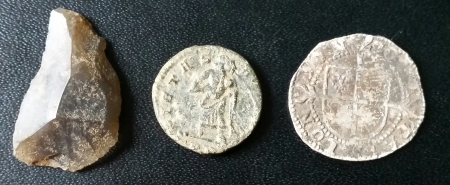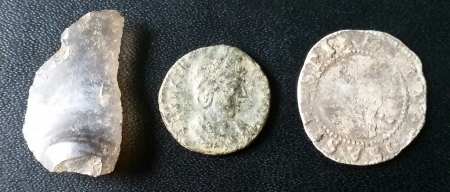Along I went to collect the items handed in in September and to hand over the latest batch.
Finds from Thame area dig – blog entry dated 1 September 2016
The flint was recorded as a Mesolithic or Neolithic rejuvenation flake dating to 8,300 – 2,100 BCE. The Lizzy Halfgroat is London mint dating to 1591 – 1594 AD. The Roman coin was confirmed as a commemorative copper alloy nummus of Theodora dating to 337 – 341 AD.
Finds from Witney area dig – blog entry dated 5 September 2016
The book clasp was confirmed as being of a copper alloy and dating to anywhere between 1500 and 1700. The curtain ring is a very ordinary copper alloy ring of mediaeval or post-mediaeval date so from anywhere between the 14th and 18th centuries. The rounded button was judged to be of 18th century date and not recorded.
Find from XP rally near Burford
The Roman coin was identified as a radiate of an unknown emperor but dated to somewhere between 260 AD and 296 AD.
The FLO took from me:
1 musket ball
1 possible musket ball
1 copper alloy ring which may be of Roman date
4 Roman coins
1 small piece of grey pottery (possibly Roman)
1 small iron nail or tack – probably a Roman boot or sandal hobnail
1 piece of reddish-orangey stone which shows possible signs of having been worked to some extent.
Sadly, all the lumps of curved orangey-pink rough ceramic are just modern drainage pipe. Bang goes my Roman building. Eheu!


